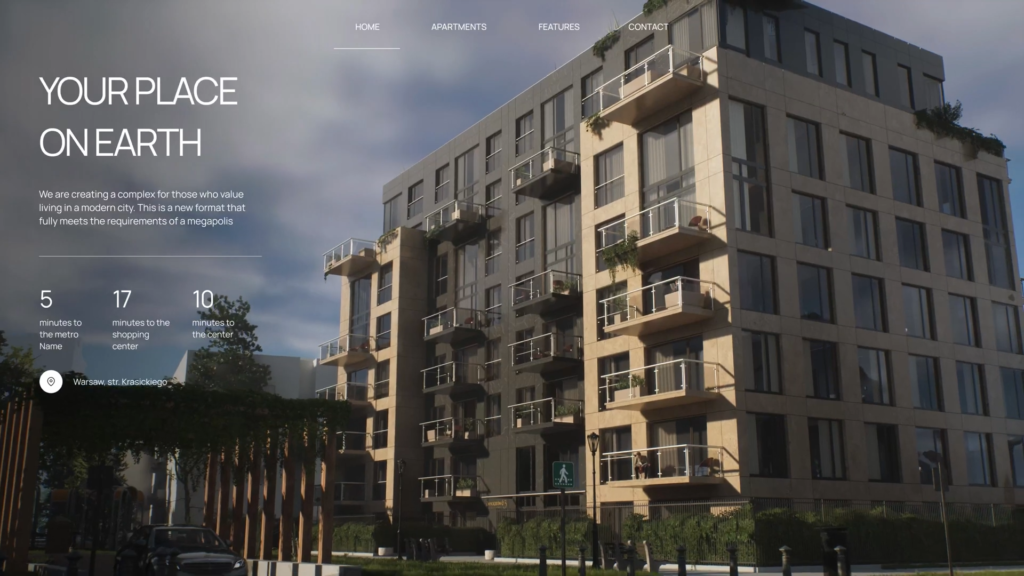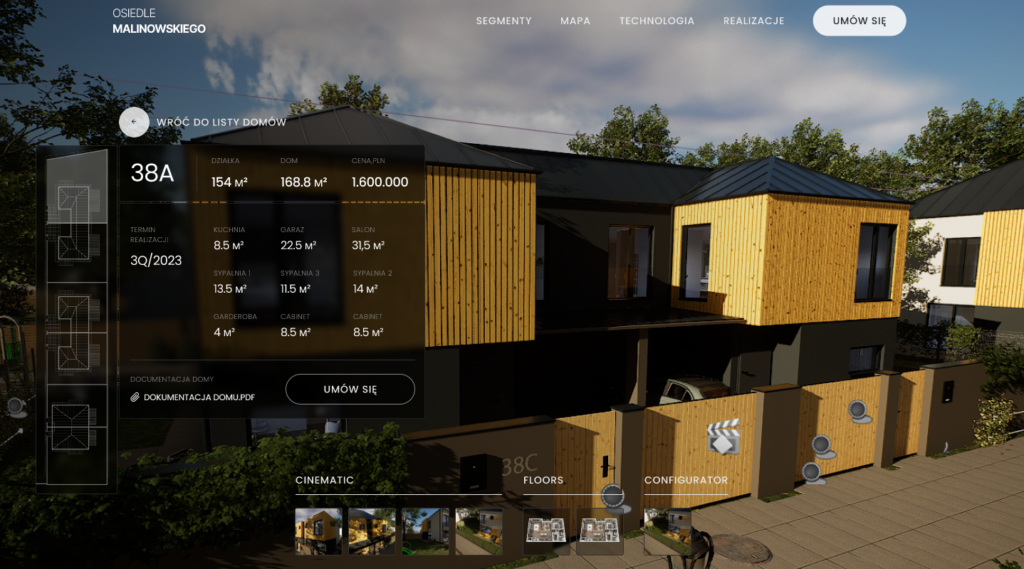24 February
ArchViz Web App Template
Business
Design
Programming
Web apps
min. read
Over the past 8 years, of working on 3D configurations we found that it’s too expensive for the end customer to justify a highly expensive software development team, to make them a premium dedicated product. They would either opt for something inexpensive in 3D that looks bad or go with old-school images which are static in nature and don’t make them appealing enough. But at last, we got something that could be non-expensive but would offer parallel functionality to a fully 3D-rendered application!
Unsatisfying solutions for ArchViz
Let’s go through all the possible solutions to the ArchViz problem and decide together if there is anything that would fit the need of a real estate market.
“Renders” – static images from a single point of view
As much as we love the beauty and realism of 3D renders, they come with a significant limitation: they are static images from a single point of view. While they can give us a sense of the layout and design of a property, they fail to capture the full experience of being in the space.
Think about it. When you’re physically present in a room, you can move around, explore different angles, and get a feel for the space in a way that just isn’t possible with a static image. This is why many real estate agents and buyers find renders unsatisfying – they simply don’t provide a comprehensive understanding of the property.
That being said, renders do have their place in the real estate market. They are a great way to showcase the overall design and layout of a property, and they can be used to generate interest and excitement. But when it comes to truly understanding a space, they fall short.
So while renders may be a useful tool for real estate marketing, they shouldn’t be relied upon as the sole representation of a property. Instead, we need to explore other solutions that can provide a more comprehensive understanding of the space.
360s or spherical images
One solution that has gained popularity in recent years is 360s or spherical images. These are essentially panoramic photos that allow viewers to look around the space and get a sense of what it’s like to be there.
While 360s’ are certainly an improvement over static renders, they still have their limitations. For one, they don’t provide the same level of detail as a fully-rendered 3D model. They also don’t allow viewers to move around the space or interact with it in any meaningful way.
There are tools on the market that allow for “blending” between the views but the transitions are unpleasant and just plain ugly.
That being said, 360s can be a valuable tool for real estate marketing. They are easy to create, can be embedded in websites and social media platforms, and provide viewers with a more immersive experience than static images.
But like renders, 360s should be used in conjunction with other tools to provide a more comprehensive understanding of the property. They can be a great way to generate interest and excitement, but they shouldn’t be relied upon as the sole representation of a space.
Full 3D experience – expensive but worth it?
For those who want the most comprehensive and immersive experience possible, a full 3D real-time rendering may be the best option. While this approach can be expensive and time-consuming to create, it offers a level of detail and interactivity that simply isn’t possible with other solutions.
With a real-time engine, viewers can explore the space in real-time, move around and interact with objects, and even change the design of the space to suit their needs. This level of customization and interactivity can be incredibly valuable for buyers who are looking for a space that meets their specific needs and preferences.
Of course, creating a full 3D model requires a significant investment of time and resources. It requires skilled designers and developers who can create a realistic and accurate representation of the space, and it can take weeks or even months to complete.
Then there is a problem of limitation over where users will be able to see this application. Full 3D is often too computationally expensive to be run on every device possible, unless we lower the graphical fidelity and expectations, but then the experience will not be even for everyone.
We also have a topic of VR application and AR augmentation. Those, although valuable for customers might create other problems like availability, problems with usage, and other seemingly minor problem that balloon with undesired consequences for businesses.
ArchViz solution from Prographers!
We get to the conclusion that although video is not a perfect medium, it’s what we are consuming every day. We are used to it, and the cinematography and clever tricks, make it look more real than it really is.

Given this knowledge and inspired by the Netflix show, “Black Mirror: Bandersnatch” we decided to create a tool that will allow your customers to decide how to view the video. Change its outcomes and preview it from any given angle. While all is confined inside cleverly cut videos.
We give you a set of controls, to select your apartment, and your viewing angles as well as to take a peek inside. All in a cinematic fashion that you control!
Know-how for the ArchViz architects
The whole process for such an application starts in Unreal Engine. We take a 3D model (or create one) from the client’s specification and put all the environment around.
Given the complexity of this part, it can take the longest, as it needs to look as good as static render but from all angles. For this project, it took us over 400 hours to get it right!
We chose Unreal Engine because of their dedication and support for 3D artists. Tools like nanite and lumen allow us to create scenes where we don’t have to worry about polygon count or about the baking process of lighting and reflections.
Tooling
Given that we are a software house this project wouldn’t be possible without programmers support. Our internal team created a set of tools for Unreal Engine and around it to make the whole process even smoother, and to make iterations as fast as possible.
From automatic rendering inside the cloud, to fully generic web template creation. We got it all!
3D scene to Videos
After the scene with the environment is ready. We create a set of cinematics shoots using Cinematics. This step is a critical one because all transitions, angles, and shoots need to be perfect. This can take around 100 hours to make it all possible for a single investment.
Each shoot is not only a simple camera transition but also sun movement, grass, and trees rippling in the wind and many other variables. Every detail matters!
Once composed 3D artist’s job is done and it’s all given to automation. A series of scripts pull the Unreal Engine scene and render cinematics that artists specially prepared. Raytracing is obviously ON for this process! Then those videos are cut into smaller pieces and uploaded into the cloud.
Given that we want the best possible performance, we found that the AV1 codec works the best for us, as it gives the best result with up to 55% less size, compared to H.256 codec. A single video in 4K resolution takes less than 2MB for a transition.
Performance
Given that performance and time waiting for us is the most important thing in the development of such an application we made a commitment to have an invisible loading of all the assets. Right now we are still in the early phases but preloading all videos gives the best results.
On a 4G (LTE) mobile traffic, we get 2 seconds of initial loading time. And then less than 300 milliseconds to get the next clip working over the interaction in Full HD.
This is almost invisible to the user as they are presented with constantly moving images all the time.
Web Template for ArchViz
After we got all that, we have a CMS dedicated to this solution that will allow you to build your own website from those videos in less than a day. The video player and all the logic are already embedded into the website template, and all you need to do is “drag and drop” your wanted components. To make your application truly interactive and engaging.

Summary
Given that we are still in alpha and most of the stuff that I mentioned in this blog is yet to be polished, we are committed to delivering the Alpha version of the most critical components of this application to you in Q2 of 2023, and full release by the end of the year.
At this moment, please sign in to the wish list to get notified first about the releases of the application. We plan to offer this Web Template as a SaaS model. So that it’s hassle-free for all of our customers. No thinking about hosting, coding, or other complex actions.
For enterprise customers, we can offer full 3D modeling of the scenes along with access afterward to the SaaS platform.
Let's talk
I agree that my data in this form will be sent to [email protected] and will be read by human beings. We will answer you as soon as possible. If you sent this form by mistake or want to remove your data, you can let us know by sending an email to [email protected]. We will never send you any spam or share your data with third parties.
I agree that my data in this form will be sent to [email protected] and will be read by human beings. We will answer you as soon as possible. If you sent this form by mistake or want to remove your data, you can let us know by sending an email to [email protected]. We will never send you any spam or share your data with third parties.